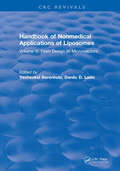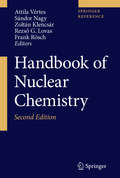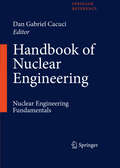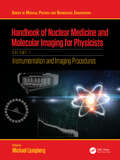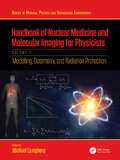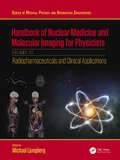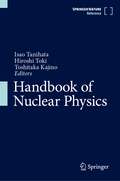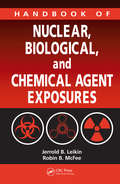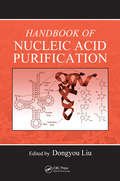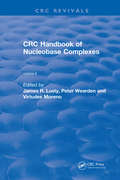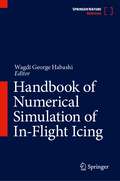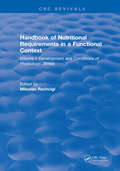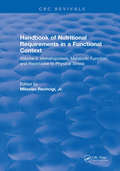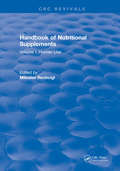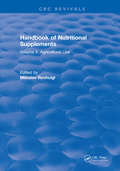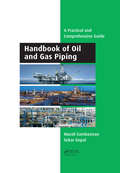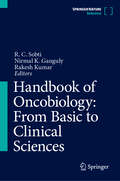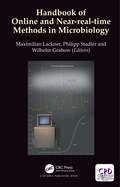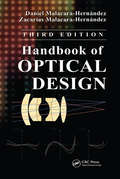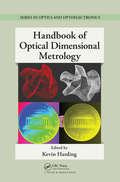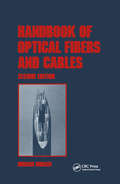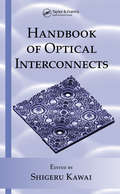- Table View
- List View
Handbook of Nonmedical Applications of Liposomes: Volume III: From Design to Microreactors (Routledge Revivals Ser. #4)
by Yechezkel BarenholzLiposomes have become an important model in fundamental biomembrane research, including biophysical, biochemical, and cell biological studies of membranes and cell function. They are thoroughly studied in several applications, such as drug delivery systems in medical applications and as controlled release systems, microencapsulating media, signal carriers, support matrices, and solubilizers in other applications. While medical applications have been extensively reviewed in recent literature, there is a need for easily accessible information on applications for liposomes beyond pharmacology and medicine. The Handbook of Nonmedical Applications of Liposomes fills this void.This unique new handbook series presents recent developments in the use of liposomes in many scientific disciplines, from studies on the origin of life, protein function, and vesicle shapes, to applications in cosmetics, diagnostics, ecology, bioreclamation, and the food industry. In these volumes many of the top experts contribute extensive reviews of their work.
Handbook of Nuclear Chemistry
by Attila Vértes Frank Rösch Sándor Nagy Rezso György Lovas Zoltán KlencsárThis revised and extended 6 volume handbook set is the most comprehensive and voluminous reference work of its kind in the field of nuclear chemistry. The Handbook set covers all of the chemical aspects of nuclear science starting from the physical basics and including such diverse areas as the chemistry of transactinides and exotic atoms as well as radioactive waste management and radiopharmaceutical chemistry relevant to nuclear medicine. The nuclear methods of the investigation of chemical structure also receive ample space and attention. The international team of authors consists of scores of world-renowned experts - nuclear chemists, radiopharmaceutical chemists and physicists - from Europe, USA, and Asia. The Handbook set is an invaluable reference for nuclear scientists, biologists, chemists, physicists, physicians practicing nuclear medicine, graduate students and teachers - virtually all who are involved in the chemical and radiopharmaceutical aspects of nuclear science. The Handbook set also provides further reading via the rich selection of references.
Handbook of Nuclear Engineering
by Dan Gabriel CacuciThe Handbook of Nuclear Engineering is an authoritative compilation of information regarding methods and data used in all phases of nuclear engineering. Addressing nuclear engineers and scientists at all academic levels, this five volume set provides the latest findings in nuclear data and experimental techniques, reactor physics, kinetics, dynamics and control. Readers will also find a detailed description of data assimilation, model validation and calibration, sensitivity and uncertainty analysis, fuel management and cycles, nuclear reactor types and radiation shielding. A discussion of radioactive waste disposal, safeguards and non-proliferation, and fuel processing with partitioning and transmutation is also included. As nuclear technology becomes an important resource of non-polluting sustainable energy in the future, The Handbook of Nuclear Engineering is an excellent reference for practicing engineers, researchers and professionals.
Handbook of Nuclear Medicine and Molecular Imaging for Physicists: Instrumentation and Imaging Procedures, Volume I (Series in Medical Physics and Biomedical Engineering)
by Michael LjungbergThis state-of-the-art handbook, the first in a series that provides medical physicists with a comprehensive overview into the field of nuclear medicine, is dedicated to instrumentation and imaging procedures in nuclear medicine. It provides a thorough treatment on the cutting-edge technologies being used within the field, in addition to touching upon the history of their use, their development, and looking ahead to future prospects. This text will be an invaluable resource for libraries, institutions, and clinical and academic medical physicists searching for a complete account of what defines nuclear medicine. The most comprehensive reference available providing a state-of-the-art overview of the field of nuclear medicine Edited by a leader in the field, with contributions from a team of experienced medical physicists Includes the latest practical research in the field, in addition to explaining fundamental theory and the field's history
Handbook of Nuclear Medicine and Molecular Imaging for Physicists: Modelling, Dosimetry and Radiation Protection, Volume II (ISSN)
by Michael LjungbergMathematical modelling is an important part of nuclear medicine. Therefore, several chapters of this book have been dedicated towards describing this topic. In these chapters, an emphasis has been put on describing the mathematical modelling of the radiation transport of photons and electrons, as well as on the transportation of radiopharmaceuticals between different organs and compartments. It also includes computer models of patient dosimetry. Two chapters of this book are devoted towards introducing the concept of biostatistics and radiobiology. These chapters are followed by chapters detailing dosimetry procedures commonly used in the context of diagnostic imaging, as well as patient-specific dosimetry for radiotherapy treatments. For safety reasons, many of the methods used in nuclear medicine and molecular imaging are tightly regulated. Therefore, this volume also highlights the basic principles for radiation protection. It discusses the process of how guidelines and regulations aimed at minimizing radiation exposure are determined and implemented by international organisations. Finally, this book describes how different dosimetry methods may be utilized depending on the intended target, including whole-body or organ-specific imaging, as well as small-scale to cellular dosimetry.This text will be an invaluable resource for libraries, institutions, and clinical and academic medical physicists searching for a complete account of what defines nuclear medicine. The most comprehensive reference available providing a state-of-the-art overview of the field of nuclear medicine Edited by a leader in the field, with contributions from a team of experienced medical physicists, chemists, engineers, scientists, and clinical medical personnel Includes the latest practical research in the field, in addition to explaining fundamental theory and the field's history
Handbook of Nuclear Medicine and Molecular Imaging for Physicists: Radiopharmaceuticals and Clinical Applications, Volume III (Series in Medical Physics and Biomedical Engineering)
by Michael LjungbergThis state-of-the-art handbook, the third and final in a series that provides medical physicists with a comprehensive overview into the field of nuclear medicine, focuses on highlighting the production and application of radiopharmaceuticals. With this, the book also describes the chemical composition of these compounds, as well as some of the main clinical applications where radiopharmaceuticals may be used. Following an introduction to the field of radiopharmacy, three chapters in this book are dedicated towards in-depth descriptions of common radionuclides and radiopharmaceuticals used during diagnostic studies utilizing planar/Single Photon Emission Computed Tomography (SPECT) imaging, in addition to during Positron Emission Tomography (PET) imaging, and, finally, radiotherapy. These chapters are followed by those describing procedures relating to quality control and manufacturing (good manufacturing practices) also encompassing aspects such as environmental compliance. Furthermore, this volume illustrates how facilities handling these chemicals should be designed to comply with set regulations. Like many pharmaceuticals, the development of radiopharmaceuticals relies heavily on the use of mouse models. Thus, the translation of radiopharmaceuticals (i.e., the process undertaken to assure that the functionality and safety of a newly developed drug is maintained also in a human context), is covered in a later chapter. This is followed by a chapter emphasising the importance of safe waste disposal and how to assure that these procedures meet the requirements set for the disposal of hazardous waste. Several chapters have also been dedicated towards describing various medical procedures utilizing clinical nuclear medicine as a tool for diagnostics and therapeutics. As physicists may be involved in clinical trials, a chapter describing the procedures and regulations associated with these types of studies is included. This is followed by a chapter focusing on patient safety and another on an imaging modality not based on ionizing radiation – ultrasound. Finally, the last chapter of this book discusses future perspectives of the field of nuclear medicine. This text will be an invaluable resource for libraries, institutions, and clinical and academic medical physicists searching for a complete account of what defines nuclear medicine. The most comprehensive reference available providing a state-of-the-art overview of the field of nuclear medicine Edited by a leader in the field, with contributions from a team of experienced medical physicists, chemists, engineers, scientists, and clinical medical personnel Includes the latest practical research in the field, in addition to explaining fundamental theory and the field's history
Handbook of Nuclear Physics
by Hiroshi Toki Isao Tanihata Toshitaka KajinoThis handbook is a comprehensive, systematic source of modern nuclear physics. It aims to summarize experimental and theoretical discoveries and an understanding of unstable nuclei and their exotic structures, which were opened up by the development of radioactive ion (RI) beam in the late 1980s. The handbook comprises three major parts. In the first part, the experiments and measured facts are well organized and reviewed. The second part summarizes recognized theories to explain the experimental facts introduced in the first part. Reflecting recent synergistic progress involving both experiment and theory, the chapters both parts are mutually related. The last part focuses on cosmo-nuclear physics—one of the mainstream subjects in modern nuclear physics. Those comprehensive topics are presented concisely. Supported by introductory reviews, all chapters are designed to present their topics in a manner accessible to readers at the graduate level. The book therefore serves as a valuable source for beginners as well, helping them to learn modern nuclear physics.
Handbook of Nuclear, Biological, and Chemical Agent Exposures
by Jerrold B. Leikin Robin B. McFeeTreating nuclear, biological, and chemical agent exposures presents a unique set of challenges. These scenarios usually involve multiple exposures, sometimes even mass exposures, from a single, often poorly-defined, event. Early symptoms are not distinct and can often be variable. Laboratory analyses may be required from environmental, often nonbio
Handbook of Nucleic Acid Purification
by Dongyou LiuAn Indispensable Roadmap for Nucleic Acid Preparation Although Friedrich Miescher described the first isolation of nucleic acid in 1869, it was not until 1953 that James Watson and Francis Crick successfully deciphered the structural basis of DNA duplex. Needless to say, in the years since, enormous advances have been made in the study of nucleic a
Handbook of Nucleobase Complexes (CRC Press Revivals)
by James R. Lusty P. Wearden V. MorenoThis handbook describes methods of preparation, characterization, toxicity, and therapeutic indices of transition metal complexes of the naturally occurring heterocyclic nucleobases and their derivatives. Modes of coordination are listed together with the relevant spectral data and major methods of investigation. Where appropriate, the spectrum of the sample is included in the pertinent section on spectroscopy. Data on the uncomplexed bases, such as solubility, pK, accepted structure(s) in the solid state and solutions, and the natural occurrence of the base are also included.Volume II of this work provides the spectroscopic data to accompany Volume I. Volume II is divided into two sections: Section 1 summarizes the data and Section 2 is comprised of figures. In Section 1, the complexes are arranged according to the method of study. In Section 2, figures are listed by base type and follow the sequence of Volume I, mainly complexes of the pyrimidine bases, nucleosides and nucleotides, and then purine bases, nucleosides, and nucleotides.
Handbook of Numerical Simulation of In-Flight Icing
by Wagdi George HabashiThis Handbook of Numerical Simulation of In-Flight Icing covers an array of methodologies and technologies on numerical simulation of in-flight icing and its applications. Comprised of contributions from internationally recognized experts from the Americas, Asia, and the EU, this authoritative, self-contained reference includes best practices and specification data spanning the gamut of simulation tools available internationally that can be used to speed up the certification of aircraft and make them safer to fly into known icing. The collection features nine sections concentrating on aircraft, rotorcraft, jet engines, UAVs; ice protection systems, including hot-air, electrothermal, and others; sensors and probes, CFD in the aid of testing, flight simulators, and certification process acceleration methods. Incorporating perspectives from academia, commercial, government R&D, the book is ideal for a range of engineers and scientists concerned with in-flight icing applications.
Handbook of Nutrient Requirements of Finfish (CRC Press Revivals)
by Robert P. WilsonA one-of-a-kind book for researchers interested in finfish nutritionHandbook of Nutrient Requirements of Finfish provides a summary of qualitative and quantitative nutrient requirements for almost all cultured finfish for which a significant amount of nutritional information now exists. Information is presented by species and includes how each species is cultured, an index of production, regional locations where each species is being cultured, examples of purified or test diets and special conditions required for laboratory studies, nutrient requirements and practical diet formulation. Discussions of special diets and feeding practices are included for certain species. This book will be a useful guide for students, researchers, practicing nutritionists, aquaculturists, and feed manufacturers interested in fish nutrition.
Handbook of Nutritional Requirements in a Functional Context: Volume I: Development and Conditions of Physiologic Stress
by Miloslav RechciglThe purpose of this Handbook is to bring together all the available information on the nutritional requirements of animal organisms for specific processes and functions. This is believed to be the first systematic treatment of nutrition in a functional context. Apart from furnishing specific nutritional data, this Handbook provides a useful framework for a comparative physiologist or biochemist searching for commonality or idfferences among various biological systems.
Handbook of Nutritional Requirements in a Functional Context: Volume II, Hematopoiesis, Metabolic Function, and Resistance to Physical Stress
by Miloslav RechciglThe purpose of this Handbook is to bring together all the available information on the nutritional requirements of animal organisms for specific processes and functions. This is believed to be the first systematic treatment of nutrition in a functional context. Apart from furnishing specific nutritional data, this Handbook provides a useful framework for a comparative physiologist or biochemist searching for commonality or idfferences among various biological systems.
Handbook of Nutritional Supplements: Volume I: Human Use (Crc Series In Nutrition And Food)
by Miloslav RechciglThe Handbook is composed of two parts, the first volume covering supplements for human usewhile the second volume is devoted to agriculture supplements. This volume, relating to food supplements for human use, is organized on the basis of raw materials utilized in their production, as well as on the basis of target groups for which they are intended.
Handbook of Nutritional Supplements: Volume II, Agricultural Use
by Miloslav RechciglThe Handbook is composed of two parts, the first volume covering supplements for human usewhile the second volume is devoted to agriculture supplements. This volume, relating to agriculture supplements, covers various food byproducts and nutritional and other food supplements used in animal feeding. In addition, it also includes information on nutrition supplements for plants.
Handbook of Nuts: Herbal Reference Library (Herbal Reference Library #4)
by James A. DukeOver one hundred of the world's most important species of nuts are systematically accounted for in this informative handbook. The text defines nuts and discusses their economic and nutritional value. For easy reference, there is an illustrated account of each nut by species, arranged alphabetically by scientific name. Each account includes the family name, several colloquial names, and paragraphs on uses, folk medicine, chemistry, germplasm, distribution, ecology, cultivation, harvesting, yields, energy, and biotic factors.Chapters Describe:UsesFolk medicineChemistryGermplasmDistributionEcologyCultivationHarvestingYields and economicsEnergyBiotic factors
Handbook of Oil and Gas Piping: a Practical and Comprehensive Guide
by Murali Sambasivan Sekar GopalThe objective of this practical oil and gas piping handbook is to facilitate project management teams of oil and gas piping related construction projects to understand the key requirements of the discipline and to equip them with the necessary knowledge and protocol. It provides a comprehensive coverage on all the practical aspects of piping related material sourcing, fabrication essentials, welding related items, NDT activities, erection of pipes, pre-commissioning, commissioning, post-commissioning, project management and importance of ISO Management systems in oil and gas piping projects. This handbook assists contractors in ensuring the right understanding and application of protocols in the project. <P><P>One of the key assets of this handbook is that the technical information and the format provided are practically from real time oil and gas piping projects; hence, the application of this information is expected to enhance the credibility of the contractors in the eyes of the clients and to some extent, simplify the existing operations. Another important highlight is that it holistically covers the stages from the raw material to project completion to handover and beyond. This will help the oil and gas piping contractors to train their project management staff to follow the best practices in the oil and gas industry. Furthermore, this piping handbook provides an important indication of the important project-related factors (hard factors) and organizational-related factors (soft factors) to achieve the desired project performance dimensions, such as timely completion, cost control, acceptable quality, safe execution and financial performance. Lastly, the role of ISO management systems, such as ISO 9001, ISO 14001 and OHSAS 18001 in construction projects is widely known across the industry; however, oil and gas specific ISO quality management systems, such as ISO 29001, and project specific management systems, such as ISO 21500, are not widely known in the industry, which are explained in detail in this handbook for the benefit of the oil and gas construction organizations. <P><P>Features: <li>Covering the stages from the raw material to project completion, to handover and beyond <li>Providing practical guidelines to oil and gas piping contractors for training purposes and best practices in the oil and gas industry <li>Emphasizing project-related factors (hard factors) and organizational-related factors (soft factors) with a view to achieve the desired project performance <li>Highlighting the roles of ISO management systems in oil and gas projects.
Handbook of Oncobiology: From Basic to Clinical Sciences
by Nirmal K. Ganguly Rakesh Kumar R. C. SobtiThis Handbook on cancer biology comprehensively reviews the current status of the oncobiology of major cancer types, cancer detection and treatment strategies, principles and processes of cancer drug development, and nanomedicine and other emerging cancer medicine applications to cancer diagnosis and treatment. The book also provides practical and implementable nutritional guidance in cancer prevention, treatment, and quality of life for cancer survivors. It discusses pharmacogenetics strategies for predicting cancer prognosis and treatment exposure, response, and toxicity. Further, it presents bioinformatics approaches for predicting anti-cancer drugs and drug combinations based on the multi-omic data, including transcriptomics, toxicogenomics, functional genomics, and biological networks. The Handbook also examines major factors and pathways that regulate cancer stem cells development and discusses potential targeted therapy for cancer stem cells. The book explores the application of the CRISPR/Cas9-based gene-editing technique in basic cancer research, diagnosis, and treatment of cancer. This Handbook is an invaluable source for oncologists, researchers, public health specialists, epidemiologists, and policy makers.
Handbook of Online and Near-real-time Methods in Microbiology
by Maximilian Lackner Wihelm Grabow Philipp StadlerRapid detection and indication of the microbiological quality of liquids is an emerging topic that has high potential for numerous applications in the fields of environmental monitoring, industrial process control and medical surveillance. Latest technologies allow online and near-real-time quantitative or qualitative microbial measurements with a significantly higher temporal resolution than traditional methods. Such novel developments will significantly enhance quality monitoring of water resources and liquids and have great capability for automation, control and optimization of industrial processes. Therefore, such methods are assumed to have major impacts on scientific research and technical applications in the near future. The book presents cutting edge research on frontiers in microbiological detection from leading experts: Seven chapters containing review articles on emerging and state-of-the-art online and near-real-time methods of microorganism detection and – indication are giving a comprehensive insight into this novel field. A balance between chapters from industry and contributions from academia was aimed for, covering the broad field of microbiological quality of waters and liquids in environmental, industrial and medical systems. This handbook also contains an extensive glossary pointing out and describing relevant terms and definitions. This handbook is the first of its kind and is a timely, comprehensive source of information for researchers and engineers in the areas of biotechnology, environmental sciences, control technology and the process industries.
Handbook of Optical Design
by Daniel Malacara-Hernández Zacarías Malacara-HernándezHandbook of Optical Design, Third Edition covers the fundamental principles of geometric optics and their application to lens design in one volume. It incorporates classic aspects of lens design along with important modern methods, tools, and instruments, including contemporary astronomical telescopes, Gaussian beams, and computer lens design. Written by respected researchers, the book has been extensively classroom-tested and developed in their lens design courses. This well-illustrated handbook clearly and concisely explains the intricacies of optical system design and evaluation. It also discusses component selection, optimization, and integration for the development of effective optical apparatus. The authors analyze the performance of a wide range of optical materials, components, and systems, from simple magnifiers to complex lenses used in photography, ophthalmology, telescopes, microscopes, and projection systems. Throughout, the book includes a wealth of design examples, illustrations, and equations, most of which are derived from basic principles. Appendices supply additional background information. What’s New in This Edition Improved figures, including 32 now in color Updates throughout, reflecting advances in the field New material on Buchdahl high-order aberrations Expanded and improved coverage of the calculation of wavefront aberrations based on optical path An updated list of optical materials in the appendix A clearer, more detailed description of primary aberrations References to important new publications Optical system design examples updated to include newly available glasses 25 new design examples This comprehensive book combines basic theory and practical details for the design of optical systems. It is an invaluable reference for optical students as well as scientists and engineers working with optical instrumentation.
Handbook of Optical Dimensional Metrology (Series in Optics and Optoelectronics)
by Kevin HardingDue to their speed, data density, and versatility, optical metrology tools play important roles in today's high-speed industrial manufacturing applications. Handbook of Optical Dimensional Metrology provides useful background information and practical examples to help readers understand and effectively use state-of-the-art optical metrology methods
Handbook of Optical Engineering (Optical Science and Engineering)
by Daniel MalacaraThis handbook explains principles, processes, methods, and procedures of optical engineering in a concise and practical way. It emphasizes fundamental approaches and provides useful formulas and step-by-step worked-out examples to demonstrate applications and clarify calculation methods. The book covers refractive, reflective, and diffractive optical components; lens optical devices; modern fringe pattern analysis; optical metrology; Fourier optics and optical image processing; electro-optical and acousto-optical devices; spatial and spectral filters; optical fibers and accessories; optical fabrication; and more. It includes over 2,000 tables, flow charts, graphs, schematics, drawings, photographs, and mathematical expressions.
Handbook of Optical Fibers and Cables, Second Edition (Optical Science and Engineering #1)
by Hiroshi MurataThis work covers the history of optical communications, fibres and fiber cables, and compares optical fibres with other transmission media. It also discusses optical fibre materials, reliability and manufacture, illustrates the design, construction and properties of recent cables used for optical fibre, describes fibre splicing and presents automated fibre splicing machines, and more.
Handbook of Optical Interconnects (Optical Science and Engineering)
by Shigeru KawaiAs we reach the data transmission limits of copper wire and communications experts seek to bring the speed of long-haul fiber optics networks closer to access points, optical interconnects promise to provide efficient, high-speed data transmission for the next generation of networks and systems. They offer higher bit-rates, virtually no crosstalk, lower demands on power requirements and thermal management, and the possibility of two-dimensional channel arrays for chip-to-chip communication.The Handbook of Optical Interconnects introduces the systems and devices that will bring the speed and quality of optical transmission closer to the circuit board. Contributed by active experts, most from leading technology companies in the US and Japan, this outstanding handbook details various low-cost and small-size configurations, illustrates the discussion with more than 300 figures, and offers a look at the applications and future of this exciting and rapidly growing field. The book includes a detailed introduction to vertical cavity surface-emitting lasers (VCSELs); the use of optical interconnects in metropolitan, local-area, and access networks through FTTP (FTTH); and Jisso technologies, which are critical for developing low-cost, small-size modules.Driving down the size and cost of optical interconnects is vital for integrating these technologies into the network and onto microprocessors, and the Handbook of Optical Interconnects provides the knowledge and tools necessary to accomplish these goals.
